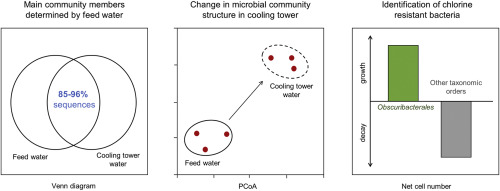Water Research ( IF 11.4 ) Pub Date : 2020-01-17 , DOI: 10.1016/j.watres.2020.115505 I.S.M. Pinel , D.H. Moed , J.S. Vrouwenvelder , M.C.M. van Loosdrecht

|
Understanding the bacterial dynamics in cooling towers is imperative for the assessment of disinfection efficiency and management of microbial risks linked to aerosol formation. The objective of this study was to evaluate the impact of feed water on the cooling water bacterial microbiome and investigate the survival ability of its members when exposed to continuous chlorine disinfection. Water from an industrial cooling water system (2600 m3/h) was collected over a 5-month period at 3 locations along the feed water line and 3 locations in the cooling tower. ATP measurements suggested that the average ATP-per-cell in the cooling tower evolved independently from the average ATP-per-cell in the feed water. Flow cytometry and 16S rRNA gene amplicon sequencing were then combined to quantify the bacterial dynamics in the whole system. A mass balance based equation was established to determine net growth and net decay of the cooling tower bacterial communities in order to evaluate the impact of continuous chlorination (0.35–0.41 mg Cl2/L residual chlorine). The results indicated that cooling tower main community members were determined by the input feed water microbiome and the bacterial community structure was further shaped by varying decay rates of the microorganisms. Notably, the order Obscuribacterales showed to be growing in the cooling tower in the presence of residual chlorine up to 0.4 mg Cl2/L, with a recurrent net growth of 260 ± 95%, taking into account the impact of the concentration factor. This conclusion was only possible thanks to the systematic analysis described in this paper and generates discussion about the resistance of Obscuribacterales to residual chlorine. The described mass balance approach provides a high level of understanding on bacterial dynamics and should be considered for future characterization studies of cooling towers in which accurate investigation of microbiome changes is essential.
中文翻译:

冷却水系统中细菌群落动态和消毒影响
了解冷却塔中的细菌动力学对于评估消毒效率和管理与浮质形成有关的微生物风险至关重要。这项研究的目的是评估给水对冷却水细菌微生物组的影响,并研究其成员在连续进行氯消毒后的存活能力。来自工业冷却水系统的水(2600 m 3/ h)是在5个月内沿给水管线的3个位置和冷却塔中的3个位置收集的。ATP测量表明,冷却塔中平均每细胞ATP的变化独立于给水中平均每细胞ATP的变化。然后将流式细胞仪和16S rRNA基因扩增子测序相结合,以量化整个系统中的细菌动力学。建立了基于质量平衡的方程式,以确定冷却塔细菌群落的净生长和净衰变,以便评估连续氯化(0.35-0.41 mg Cl 2/ L余氯)。结果表明,冷却塔的主要群落成员由输入的给水微生物组确定,细菌群落结构通过改变微生物的腐烂率而进一步成形。值得注意的是,考虑到浓缩因子的影响,在残留氯高达0.4 mg Cl 2 / L的情况下,在冷却塔中生长的梭菌属细菌正在生长,其循环净生长为260±95%。该结论只有通过本文中所述的系统分析才有可能,并且引起了关于假杆菌的抗药性的讨论。残留氯。所描述的质量平衡方法可高度了解细菌动力学,应考虑用于冷却塔的未来表征研究,在该研究中,准确研究微生物组变化至关重要。











































 京公网安备 11010802027423号
京公网安备 11010802027423号